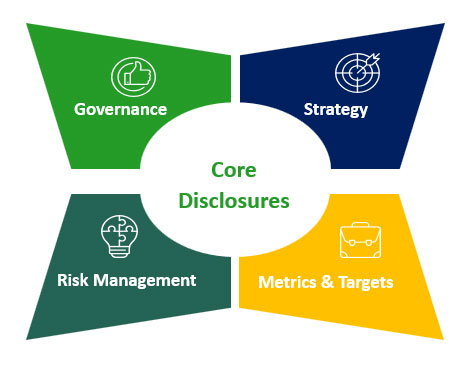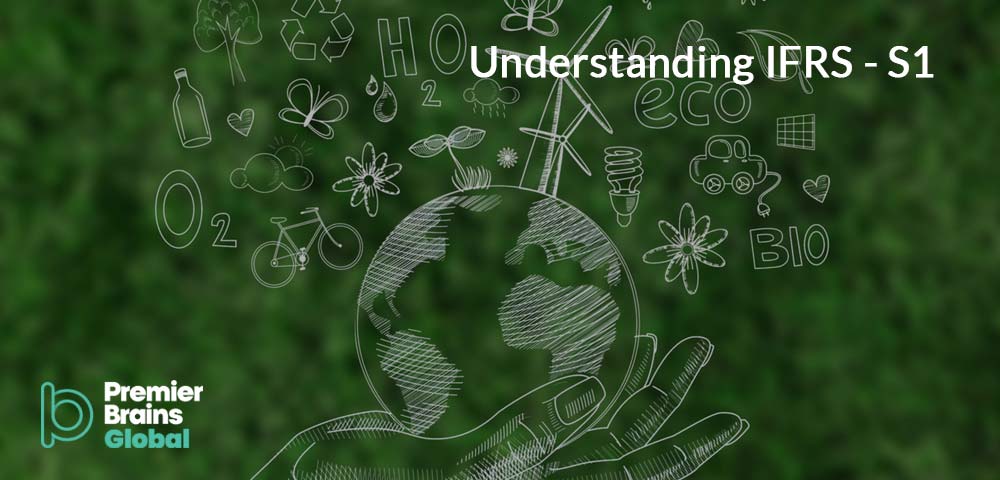Understanding IFRS - S1:
(General Requirements for Disclosure of Sustainability-related Financial Information)
In today's rapidly changing business landscape, sustainability and environmental issues are becoming increasingly important to investors and stakeholders. World is moving towards SUSTAINABLE FINANCIING which involves taking environmental, social, and governance considerations into account when making investment decisions. As a result, there is a growing demand for companies to disclose relevant information on their sustainability practices and the financial impact of these practices. To address this need, International Financial Reporting Standard Foundation (IFRS) setup the International Sustainability Standards Board (ISSB) who sits alongside the International Accounting Standards Board (IASB) and has developed IFRS - S1, a standard that outlines the general requirements for the disclosure of sustainability-related financial information.
This Article provides practical advice for organizations wishing to get a head start, thoughts on the interaction between IFRS S1 and existing reporting requirements, and lessons learned.
History of IFRS – S1
In March 2022 the International Sustainability Standards Board (ISSB) published Exposure Draft IFRS S1 General Requirements for Disclosure of Sustainability-related Financial Information, proposing general requirements for an entity to disclose sustainability-related financial information about its sustainability-related risks and opportunities. The Exposure Draft also proposed that an entity provide a complete set of sustainability-related financial disclosures.
The ISSB redeliberated the proposals after considering the feedback on the Exposure Draft. In June 2023 the ISSB issued IFRS S1 General Requirements for Disclosure of Sustainability-related Financial Information.
What is IFRS - S1?
IFRS - S1, also known as the General Requirements for Disclosure of Sustainability-related Financial Information, is a sustainability standard that aims to provide transparency and comparability in the reporting of sustainability-related financial information. It requires entities to disclose information about sustainability-related risks and opportunities that could affect their cash flows, access to finance, or cost of capital in the short, medium, or long term.
Key Objectives of IFRS - S1
Transparency:
The main objective of IFRS - S1 is to promote transparency in the reporting of sustainability-related financial information. By requiring companies to disclose relevant information, investors and stakeholders can make more informed decisions about the financial implications of sustainability practices.
Comparability:
IFRS - S1 aims to facilitate comparability across different entities and jurisdictions. The standard provides a common basis for reporting sustainability related financial information, allowing investors to compare the performance of different companies in a consistent manner.
Comparability:
IFRS - S1 focuses on materiality, meaning that companies are required to disclose information that is relevant and has a significant impact on their financial performance. This ensures that only the most important sustainability-related information is disclosed, avoiding unnecessary burden on companies.
What to Disclose?

Unless another IFRS Sustainability Disclosure Standard permits or requires otherwise in specified circumstances, an entity shall provide disclosures about;
- 1.
-
Governance: The governance processes, controls and procedures the entity uses to monitor and manage sustainability-related risks and opportunities;
To achieve this objective, an entity shall disclose the below information;
- A.
- The governance body(s) (which can include a board, committee or equivalent body charged with governance) or individual(s) responsible for oversight of sustainability related risks and opportunities.
- B.
- Management’s role in the governance processes, controls and procedures used to monitor, manage and oversee sustainability related risks and opportunities.
- 2.
-
Strategy: The approach the entity uses to manage sustainability related risks and opportunities:
To achieve this objective, an entity shall disclose the below information;
- A.
-
The sustainability-related risks and opportunities that could reasonably be expected to affect the entity’s prospects.
- ●
- Details shall specify the time horizons—short, medium or long term—over which the effects of each of those sustainability-related risks and opportunities could reasonably be expected to occur.
- ●
- How the entity defines ‘short term’, ‘medium term’ and ‘long term’ and how these definitions are linked to the planning horizons used by the entity for strategic decision-making
- B.
-
A description of the current and anticipated effects of sustainability related risks and opportunities on the entity’s business model and value chain.
- ●
- A description of where in the entity’s business model and value chain sustainability related risks and opportunities are concentrated (for example, geographical areas, facilities and types of assets).
- C.
-
The current and anticipated effects of those sustainability-related risks and opportunities on entities strategies and decision making.
- ●
- How the entity has responded to, and plans to respond to, sustainability-related risks and opportunities in its strategy and decision-making.
- ●
- The progress against plans the entity has disclosed in previous reporting periods, including quantitative and qualitative information.
- D.
-
The sustainability-related risks and opportunities that could reasonably be expected to affect the entity’s financial position, financial performance and cashflows.
- ●
- Details of impact for which there is a significant risk of a material adjustment within the next annual reporting period to the carrying amounts of assets and liabilities reported in the related financial statements.
- ●
- Its investment plans, disposal plans and planned sources of funding to implement its strategy.
- E.
-
The resilience of the entity’s strategy, its business model and its capacity to adjust to the uncertainties arising from sustainability-related risks.
- ●
- Disclose a qualitative and, if applicable, quantitative assessment of the resilience of its strategy and business model in relation to its sustainability-related risks, including information about how the assessment was carried out and its time horizon.
- 3.
-
Risk Management: The processes the entity uses to identify, assess, priorities and monitor sustainability-related risks and opportunities;
To achieve this objective, an entity shall disclose the below information;
- A.
-
Description about entity’s processes to identify, assess, prioritize and monitor sustainability-related risks and opportunities, including whether and how those processes are integrated into and inform the entity’s overall risk management process.
- ●
- What inputs and parameters the entity uses.
- ●
- How the entity uses scenario analysis
- ●
- How the entity assesses the nature, likelihood and magnitude of the effects.
- ●
- How the entity changed the processes it uses compared with the previous reporting period.
- B.
- Assessment of the entity’s overall risk profile and its overall risk management process.
- 4.
-
Metrics and Targets: The entity’s performance in relation to sustainability related risks and opportunities, including progress towards any targets the entity has set or is required to meet by law or regulation.
To achieve this objective, an entity shall disclose the below information;
- A.
-
An entity shall disclose, for each sustainability-related risk and opportunity that could reasonably be expected to affect the entity’s prospect.
- ●
- Metrics the entity uses to measure and monitor sustainability-related risk or opportunity, its performance and progress towards the targets.
- ●
- How the metric is defined, including whether it is derived by adjusting a metric taken from a source other than IFRS Sustainability Disclosure Standards.
- B.
-
An entity shall disclose information about the targets it has set to monitor progress towards achieving its strategic goals.
- ●
- The metric used to set the target and to monitor progress towards reaching the target.
- ●
- The specific quantitative or qualitative target the entity has set or is required to meet.
- ●
- The period over which the target applies.
- ●
- The base period from which progress is measured.
- ●
- Any milestones and interim targets.
- ●
- Performance against each target and an analysis of trends.
- ●
- Any revisions to the target and an explanation for those revisions.
When to Adopt IFRS – S1?
Whilst the new standards will be effective from 1 January 2024, it is up to each jurisdiction to decide on the timing of adoption and implementation. However, organizations are allowed to opt for early implementation of the standard.
Which Industry to Relevant?
IFRS S1 has been designed to apply to all types of organizations, regardless of size, location, or industry. However, there are mechanisms in place to allow businesses to disclose information in a way that is proportionate to their size and circumstances, for example, in line with their exposure to particular sustainability risks and opportunities.
When to Report?
An entity shall report its sustainability-related financial disclosures at the same time as its related financial statements. The entity’s sustainability related financial disclosures shall cover the same reporting period as the related financial statements.
How Does IFRS - S1 Benefit Companies?
Adopting IFRS - S1 and disclosing sustainability-related financial information can bring several benefits to companies:
Enhanced Stakeholder Engagement: By providing transparent information about their sustainability practices, companies can engage better with their stakeholders, including investors, customers, employees, and regulators. This can build trust and strengthen relationships with key stakeholders.
Improved Investor Decision-Making: Investors are increasingly considering sustainability factors when making investment decisions. By disclosing sustainability-related financial information in line with IFRS - S1, companies can provide investors with the information they need to assess the long-term financial viability and performance of the company.
Better Risk Management: Identifying and disclosing sustainability-related risks and opportunities can help companies better manage these risks, leading to improved resilience and long-term sustainability. This can help companies navigate regulatory changes, mitigate reputational risks, and seize opportunities arising from changing market demands.
IFRS - S1 vs. Other Sustainability Reporting Standards
IFRS - S1 is not the only sustainability reporting standard available. Other standards include the Global Reporting Initiative (GRI), the Sustainability Accounting Standards Board (SASB), and the Task Force on Climate-related Financial Disclosures (TCFD).
While these standards share similar objectives regarding sustainability reporting, they differ in their scope, requirements, and reporting frameworks. Companies may choose to comply with multiple reporting standards, depending on their industry and stakeholder expectations.
Conclusion
IFRS - S1 is a critical step towards standardizing the reporting of sustainability-related financial information. By disclosing material information about sustainability risks and opportunities that can impact their financial performance, companies can effectively manage these factors and drive long-term value for their stakeholders. As the demand for transparency and sustainability reporting continues to grow, businesses that adopt IFRS - S1 can demonstrate their commitment to responsible and sustainable business practices, while also ensuring their financial viability in the long term.
How Premier Brains Can Help
Companies need to commit sufficient time and resources now to ensure they identify the spectrum of risks and opportunities for their business models and future plans, including setting targets which are monitored and measured. This involves changes to processes, controls and governance and is a significant development in the drive to support the flow of capital to sustainable enterprises and to help make global capital markets more resilient.
At Premier Brains, we are committed to inspiring greater confidence and trust, with a comprehensive understanding of the businesses we serve and enhanced transparency through our audits. We do have the expertise in the governance design, risk assessment, planning and impact assessment of the applicable standards. We recognize that stakeholders require greater assurance and value from the audit. They rely on our work and insights, as trusted professional advisors, who bring rigor and appropriate perspectives that help inform decision-making.
 United Arab Emirates
United Arab Emirates

